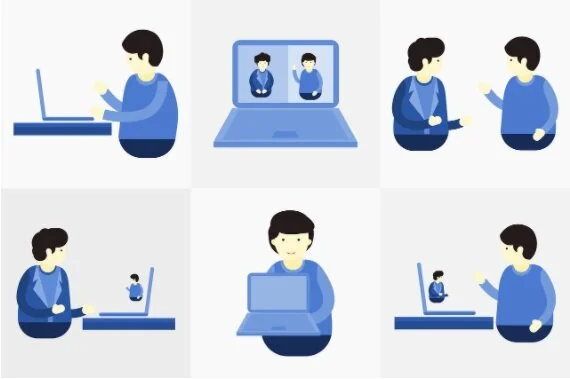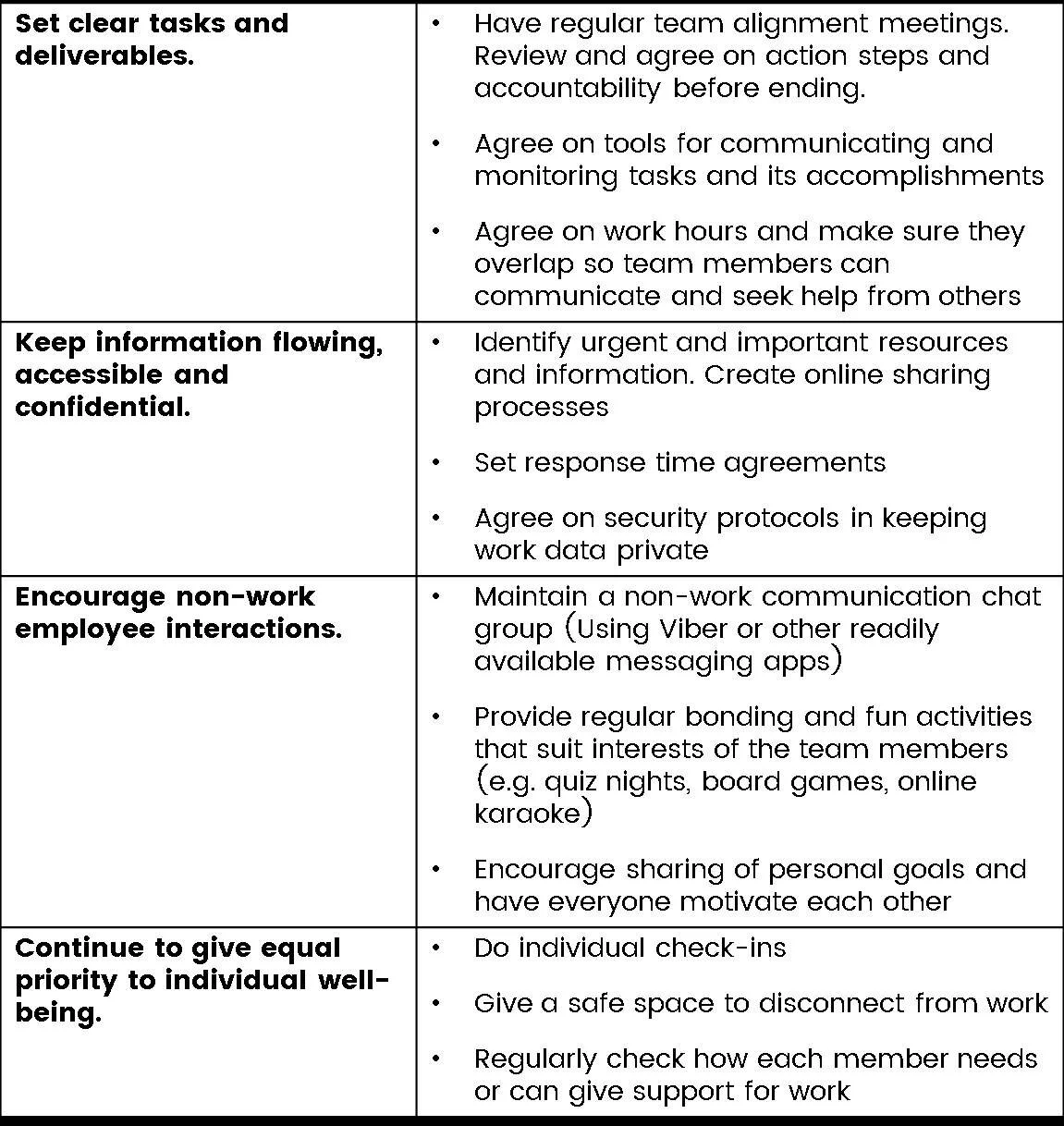Virtual Teams and Remote Work: Setting the Right Foundation
The recent VUCA (Volatile, Uncertain, Complex, Ambiguous) situation due to COVID-19 created a seemingly overnight need for businesses to set up remote working conditions for their organizations. For businesses, remote working for social distancing is certainly a way to support the call of the World Health Organization to address the pandemic [1]. The support given by many organizations towards this direction definitely goes a long way in helping solve this crisis; however, this does pose serious challenges, even for well-established companies. It is already quite difficult setting up remote work for just a handful of employees, let alone, thousands of them in a short time. This may even be a new reality we all have to deal with given the uncertainty of how long we’ll have to practice social distancing to manage the pandemic. Like it or not, virtual teams and remote work may be here to stay.
General advice regarding this transition focuses on two things: ensuring the safety and welfare of employees and getting the infrastructure right [8][9]. While we at Team Journeys may not be able to help with infrastructure concerns (setting up your virtual network, ensuring data security, etc.), we have a couple of insights in helping you and members of your team transition the way you work as a team!
To transition your team more successfully into remote working, it is crucial to understand the changes in the work environment that will affect your team when they make (or made) the transition to remote work. This can help you and your team to identify possible roadblocks or challenges along the way and how to address them. Here are a couple of remote work challenges [2]:
Lack of management-employee interactions. When you remove a physical office, you also take away the usual interaction between managers and their direct reports. While too much micromanagement is a negative for both managers and employees, absence or lack of interaction can cause confusion regarding responsibilities and output expectations, decrease in trust between supervisors and direct reports, and decrease in motivation to work for employees. Employees can no longer just head to the manager’s desk to ask for clarification on a particular matter.
Inconsistent information and impeded resources. A physical workspace can provide immediate information and resource sharing between team members. Similar to the interaction with managers, employees will start finding it difficult to get files and documents from colleagues as compared to sharing a physical space together.
Decrease in informal social interactions. The proverbial “water cooler”, “coffee station”, or “yosi/merienda break” is gone together with the physical office. Social interaction helps build team dynamics by strengthening relationships among team members. The “water cooler”/”coffee station” offered a chance for quick conversation amongst team members where they could catch up with each other on a more personal level.
Difficulty in balancing work and personal life. While there are already many distractions provided by social media and online gaming, moving work to one’s home worsens the situation. There are household chores, family members wanting to spend time, or even just your bed being within arms reach - all make it difficult for employees, and even managers, to focus on work. There’s also a concern on work boundaries. Since we’re all at home all the time, when is it work time and when is it personal time?
What’s interesting about these common remote work challenges is that they are similar to challenges that even physical workspace teams encounter when they are in their early stages of team development. In Tuckman’s stages of team development [3], we see teams journey from forming, storming, norming to performing stages. When a team that’s already in the performing stage goes through major changes, some form of reorganization will happen which can take them back to either the forming or storming stage of team development. Lack of clarity on tasks, roles, and ways of working (norms) and even an increase in conflict (that may not have existed prior to moving from physical to virtual) usually describe teams that are in these early stages. A good advice is to simply re-establish the way these aspects of work are done through virtual means. Here are a few good examples supported by experiences of companies and analysis by experts [2][4][5][6][7], along with behaviors to support them:
Set clear tasks and deliverables. One thing that definitely helps get work done is being clear on what needs to be achieved. Have a clear process on how to regularly set, communicate, and monitor team and individual tasks. It also helps to identify working hours for everyone and keep those working hours clear of any distractions.
Keep information flowing and accessible. Information and communication are certainly important, especially in difficult times like these. Regular access to information and dependable response can impact the way individuals and teams work. Make sure to agree on how members can access information and resources that they need to fulfill the tasks you’ve set together. Information on company decisions and policies also need to be conveyed clearly and quickly to also motivate employees in the direction of the company.
Encourage non-work employee interactions. As mentioned earlier, social interaction is definitely vital in improving and maintaining team dynamics. Team member relationships help bridge over the challenges in communicating virtually. Luckily for us, technology has created many ways for us to socialize virtually. Simple solutions such as “no work” chat groups or playing online games together (during the downtime of course) can help a lot.
Continue to give equal priority to individual well-being. This aspect could not be stressed enough. Paying attention to how individual team members are doing is crucial to making a team effective, whether your setup is virtual or physical. This is immensely important particularly in the conversation on the COVID-19 pandemic. Regularly check on your team members personally to see how they are doing and ask how you can support each other to do work. Also, make sure to respect work-life boundaries to ensure that work time does not negatively affect their personal lives.
These are, without a doubt, trying times for everyone professionally and personally. It is our hope that we could all make the necessary adjustments for our safety and security. We here at Team Journeys will continue to provide tips and activities to support teams adapting to the realities of virtual teams and remote work. Do check out our “work-from-home” challenges for teams to continue their team development despite the requirement for social distancing. Keep up the high-performance while still keeping safe!
Sources:
Ghebreyesus, Tedros Adhanom, M.D. “WHO Director-General's opening remarks at the media briefing on COVID-19.” World Health Organization, 13 March 2020, https://www.who.int/dg/speeches/detail/who-director-general-s-opening-remarks-at-the-mission-briefing-on-covid-19---13-march-2020
Larson, B., Makarius, E., & Vroman, S. “A Guide to Managing Your (Newly) Remote Workers” Harvard Business Review, 18 March 2020, https://hbr.org/2020/03/a-guide-to-managing-your-newly-remote-workers
“The 4 stages of team development.” Team Journeys, 5 October 2018, https://www.teamjourneys.com/blog/the-4-stages-of-team-stages-team-journeys-ph
Watkins, Michael “Making Virtual Teams Work: Ten Basic Principles”, Harvard Business Review, 27 June 2013, https://hbr.org/2013/06/making-virtual-teams-work-ten
Baldassarre, Rocco “10 Ways to Successfully Manage Virtual Teams”, Entrepreneur (Asia Pacific), 24 March 2015, https://www.entrepreneur.com/article/244197
Dhawan, E. & Chamorro-Premuzic, Tomas “How to Collaborate Effectively If Your Team Is Remote”, Harvard Business Review, 27 February 2018, https://hbr.org/2018/02/how-to-collaborate-effectively-if-your-team-is-remote
Wiles, Jackie “Early COVID-19 Lessons Learned from Employers in Asia”, Smarter with Gartner, Gartner, 23 March 2020 https://www.gartner.com/smarterwithgartner/early-covid-19-lessons-learned-from-employers-in-asia/
Neeley, Tsedal “15 Questions about Remote Work, Answered” Harvard Business Review, 16 March 2020, https://hbr.org/2020/03/15-questions-about-remote-work-answered
Ferrazzi, Keith “Getting Virtual Teams Right” Harvard Business Review, December 2014, https://hbr.org/2014/12/getting-virtual-teams-right


